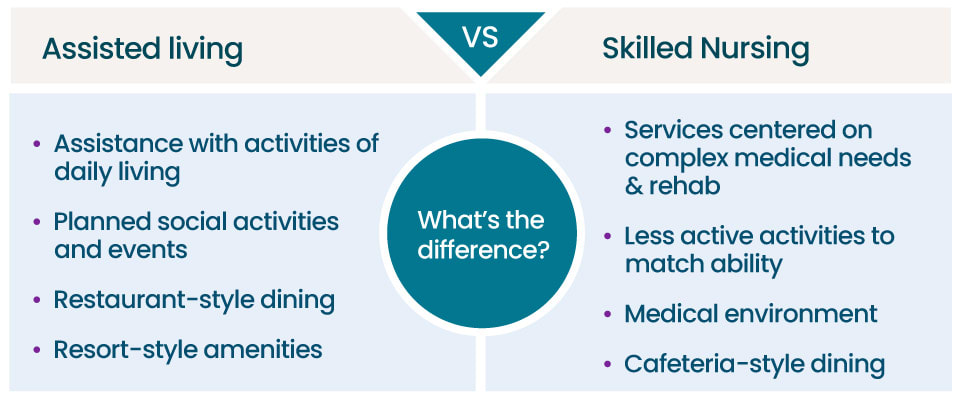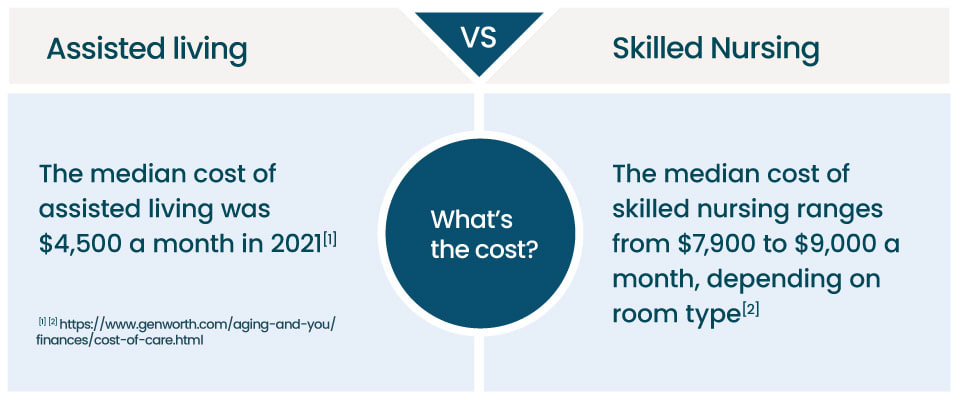
Assisted Living vs. Skilled Nursing: What’s the Difference?

With various types of senior care available, selecting the right one for an aging parent or loved one can be a dizzying experience. Assisted living and skilled nursing facilities are two senior living options for those who need extra assistance and can’t live independently, either temporarily or for the long term.
Although seniors can receive supportive services from both assisted living and skilled nursing care, these facilities aren’t the same. Every senior has their own care needs, and some communities may be better suited to meet those than others.
Let our care assessment guide you
Our free tool provides options, advice, and next steps based on your unique situation.
Key Takeaways
- A person’s care needs will ultimately determine the optimal care choice. Assisted living and skilled nursing are each ideal for different levels of need.
- Both facilities offer similar services and amenities. However, assisted living focuses more on residents’ mental health and social connections, while skilled nursing services are primarily centered on medical needs.
- Skilled nursing facilities are usually a temporary living option. This type of care is typically geared towards someone recovering from a hospitalization or experiencing a decline in health, and needs access to round-the-clock nursing support.
- Assisted living communities offer a long-term housing option. These communities benefit seniors who need some extra help with activities of daily living but wish to continue living independently.
So, how do you know what senior living option is the right fit when aging at home isn’t an option? Learning about the different features and benefits of both can help you find the right care solution for you or your loved one.
What’s the main difference between skilled nursing and assisted living?

Assisted living communities offer a long-term housing option for seniors that want to enjoy their independence but need some extra help with activities of daily living (ADLs). Skilled nursing provides more intensive medical care to patients that require around-the-clock support for an injury or illness.

Let our care assessment guide you
Our free tool provides options, advice, and next steps based on your unique situation.
Considering care needs
Services and amenities offered
Many assisted living communities have services and amenities that create the feeling of an all-inclusive retreat. A skilled nursing facility offers its own set of amenities and services, but the specialized environment makes it feel more like staying in a hospital rather than a hotel.
Assisted living amenities
Assisted living communities tend to offer services and amenities that promote residents’ well-being and social interactions. Residents are generally in charge of their own schedules and can fill their days with the activities they enjoy the most.
There’s an abundance of amenities and services provided by assisted living communities. They can include:
- Barber and beauty services
- Transportation to appointments and other errands
- Fitness studios and wellness programs
- Engaging community activities and outings
- On-site devotional services
- Dining options — meals are usually served in the community dining room, but residents may prefer cooking in their own kitchens or kitchenettes as well
Skilled nursing services
Skilled nursing patients can enjoy similar amenities to those provided in assisted living, such as daily meals, activity programs, and housekeeping. However, the services tend to be more centered on medical care, such as:
- IV therapies and medications
- Wound treatment
- Pharmacy services
- Regular vital sign monitoring
- Artificial respiration, such as ventilator care or respiratory therapy
- End-of-life or hospice care
Additionally, a person living in a skilled nursing facility may have a more limited schedule than someone in assisted living, depending on the amount of medical care needed, and scheduled activities are usually less active or strenuous. Some activities can be provided in a group setting, or one-on-one if a patient can’t leave their room, and may include:
- Reading or storytelling
- Pet therapy
- Art projects or simple crafts
Living accommodations
Residents can expect to live in a homelike atmosphere in assisted living. With skilled nursing, care is provided in more of a medical setting.
What assisted living looks like
Assisted living communities offer care from a more residential-type setting than a skilled nursing facility might. These communities typically have a main dining room for residents to enjoy restaurant-style meals, as well as shared indoor and outdoor common areas for scheduled community activities.
Residents usually live in private and semi-private apartment-like residences that come equipped with:
- Full-sized kitchens or kitchenettes
- Private bathrooms
- Safety features, such as emergency call systems or grab bars
This apartment lifestyle can accommodate the differing needs of elderly couples, such as if one spouse needs help with ADLs while the other is independent. Residents are typically encouraged to decorate their space with their own personal items, which helps give it a homelike feel and makes the transition process a bit easier.
What skilled nursing looks like
Skilled nursing usually takes place in a medical setting, such as a nursing home, hospital, or rehabilitation center. However, some health agencies may offer skilled nursing services in residents’ homes.
Similar to assisted living communities, a skilled nursing facility often has a communal dining room for residents to eat their meals, depending on their health, where meals are typically served cafeteria-style. Many skilled nursing facilities also have common areas, where they host activities such as:
- Gardening
- Low-impact exercises, such as chair yoga or stretching
- Board games, puzzles, and cards
- Special events for birthdays and holidays
Living accommodations in a skilled nursing facility have a more hospital-like feel than in assisted living communities. Since skilled nursing is usually a short-term living option, with 25% of patients staying for three months or less,[01] the rooms aren’t usually decorated with personal items. Living spaces in a skilled nursing facility typically offer:
- Private or semi-private rooms
- An en suite bathroom
- A call button
- Window coverings
- Some furniture, which can include a bed, a night stand, and wardrobe or a dresser

Talk with a Senior Living Advisor
Our advisors help 300,000 families each year find the right senior care for their loved ones.
Facility costs

Costs related to assisted living and skilled nursing facilities vary due to a number of factors, such as size, location, and services offered.
How much is assisted living?
Assisted living communities are generally less costly than skilled nursing facilities since they don’t provide full-time medical care. Many assisted living communities have base fees that include the costs of:
- Rent
- Basic utilities, which varies by community
- Care coordination
- Housekeeping services
- Activities and programs
- Daily meals, including snacks
- Transportation, though some communities may provide at an additional cost
Assisted living communities may also have extra fees such as:
- Internet service
- Pet fees and services, such as walking or grooming
- One-time fees — also called move-in or entrance fees — that can range from $2,000 to $5,000
Residents typically pay out of pocket for assisted living, but some communities may accept payment from Medicare, Medicaid, or long-term care insurance policies.
How much is skilled nursing?
Skilled nursing is generally the most expensive form of senior care due to the higher level of support needed. The monthly rate covers the costs of the following services:
- Dietitian-approved meals
- Rehabilitative therapies and treatments
- Room rate
- Full-time medical staff and round-the-clock nursing care
- Security and safety features, such as grab bars and alarm systems
Unlike many assisted living communities, skilled nursing care can be covered by most long-term care insurance policies and government assistance programs such as Medicare and Medicaid.
When is skilled nursing a better fit than assisted living?
When it comes to deciding on skilled nursing versus assisted living, a majority of the decision will come down to how much care is needed. Skilled nursing may be a better fit for someone if they have more challenging medical needs than assisted living communities can provide care for. It may also be a better option for those who need:
- Round-the-clock nursing and medical care
- Speech, physical, and occupational rehabilitation services
- Palliative care
- Nutritional care or therapeutic diets
- Assistance walking and standing
In short, a skilled nursing facility is ideal for someone who just had a hospitalization or experienced medical issues, such as a heart attack or stroke.
Read related article:Skilled Nursing Facility vs. Rehab Center: How to Choose
When should a person go into assisted living?
Seniors will likely seek assisted living as a permanent living solution when they’re still generally active but it’s no longer safe for them to live at home. Assisted living may be a good fit for seniors who:
- Feel lonely
- Need help with two or more ADLs
- Struggle to maintain their home or complete household chores
- Need minimal nursing care or medical assistance
- Want to socialize and make new friends
- Have experienced a decline in mobility
Assisted living is optimal for seniors who want to preserve their independence as long as possible, while having help available when it’s needed.
Choosing the right facility
When it comes to choosing between skilled nursing and assisted living, deciding which type of facility can best support your or a loved one’s care needs is the easiest part. Once that’s been established, you can get started researching, touring, and comparing those types of facilities to find the right match.
Whether you’re looking at assisted living communities or skilled nursing facilities, A Place for Mom’s Senior Living Advisors can help you every step of the way. They’ll take the time to learn about your family’s unique needs and point you to different senior care options in your area.
Key Takeaways
Health In Aging. (2022, October). Nursing homes.
Genworth Financial, (2022, February 07). Genworth cost of care survey.
Assisted living in all states
The information contained on this page is for informational purposes only and is not intended to constitute medical, legal or financial advice or create a professional relationship between A Place for Mom and the reader. Always seek the advice of your health care provider, attorney or financial advisor with respect to any particular matter, and do not act or refrain from acting on the basis of anything you have read on this site. Links to third-party websites are only for the convenience of the reader; A Place for Mom does not endorse the contents of the third-party sites.
Make the best senior care decision
Make the best senior care decision